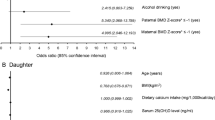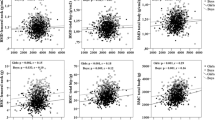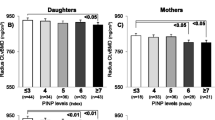Abstract
Summary
A daughter’s bone mineral density (BMD) is significantly correlated with her mother’s BMD, but the daughter’s body mass index (BMI) could modulate this association. Maternal inheritance dominantly affects daughters with a lower BMI, but BMI could compensate for hereditary influences in daughters with a higher BMI in terms of daughter’s BMD.
Introduction
Achieving optimal peak bone mass at a young age is the best way to protect against future osteoporosis and subsequent fractures. Although environmental components influence bone mass accrual, but peak bone mass is largely programmed by inheritance. The aims of this study were to investigate the influence of maternal inheritance on the daughter’s bone mass and to assess whether these influences differ according to the daughter’s body mass index (BMI).
Methods
We used data obtained from the 2010 Korean National Health and Nutrition Examination Survey V and included 187 mother–daughter pairs. Bone mineral density (BMD) was measured at the lumbar spine (LS), femur neck (FN), and total hip (TH) by using dual-energy X-ray absorptiometry (DXA). The daughter group was stratified into two groups according to the mean BMI (21.4 kg/m2).
Results
The daughters’ BMD correlated significantly with both their BMI and their mothers’ Z-score for each skeletal site. In the daughters with a lower BMI (≤21.4 kg/m2), the BMDs at the FN and TH were affected more by the mothers’ Z-score than by the daughters’ BMI. Meanwhile, the influence of the daughters’ BMI on their BMD was higher than that of their mothers’ Z-score in daughters with a higher BMI (>21.4 kg/m2). Moreover, the mothers’ Z-scores were a significant predictor of their daughters having Z-scores < −1.0 only in daughters with a lower BMI.
Conclusions
This study suggests that maternal inheritance is an important determinant of the daughters’ bone mass, but that this hereditary factor may vary according to the daughters’ BMI.

Similar content being viewed by others

Abbreviations
- LS:
-
Lumbar spine
- FN:
-
Femur neck
- TH:
-
Total hip
- DXA:
-
Dual-energy x-ray absorptiometry
- BMI:
-
Body mass index
References
Cummings SR, Melton LJ (2002) Epidemiology and outcomes of osteoporotic fractures. Lancet 359:1761–1767
Bliuc D, Nguyen ND, Milch VE, Nguyen TV, Eisman JA, Center JR (2009) Mortality risk associated with low-trauma osteoporotic fracture and subsequent fracture in men and women. JAMA 301:513–521
Cauley JA (2013) Public health impact of osteoporosis. J Gerontol A Biol Sci Med Sci 68:1243–1251
Reginster JY, Burlet N (2006) Osteoporosis: a still increasing prevalence. Bone 38:S4–S9
Lee YK, Yoon BH, Koo KH (2013) Epidemiology of osteoporosis and osteoporotic fractures in South Korea. Endocrinol Metab (Seoul) 28:90–93
Nojiri S, Burge RT, Flynn JA, Foster SA, Sowa H (2013) Osteoporosis and treatments in Japan: management for preventing subsequent fractures. J Bone Miner Metab 31:367–380
Ballane G, Cauley JA, Luckey MM, Fuleihan GE (2014) Secular trends in hip fractures worldwide: opposing trends east versus west. J Bone Miner Res 29(8):1745–1755
NIH Consensus Development Panel on Osteoporosis Prevention, Diagnosis, and Therapy (2001) Osteoporosis prevention, diagnosis, and therapy. JAMA 285:785–795
Harvey N, Dennison E, Cooper C (2014) Osteoporosis—a lifecourse approach. J Bone Miner Res 29(9):1917–1925
Rizzoli R, Bonjour JP, Ferrari SL (2001) Osteoporosis, genetics and hormones. J Mol Endocrinol 26:79–94
Pollitzer WS, Anderson JJ (1989) Ethnic and genetic differences in bone mass: a review with a hereditary vs environmental perspective. Am J Clin Nutr 50:1244–1259
Seeman E, Hopper JL, Bach LA, Cooper ME, Parkinson E, McKay J, Jerums G (1989) Reduced bone mass in daughters of women with osteoporosis. N Engl J Med 320:554–558
Barthe N, Basse-Cathalinat B, Meunier PJ, Ribot C, Marchandise X, Sabatier JP, Braillon P, Thevenot J, Sutter B (1998) Measurement of bone mineral density in mother-daughter pairs for evaluating the family influence on bone mass acquisition: a GRIO survey. Osteoporos Int 8:379–384
Kuroda T, Onoe Y, Miyabara Y, Yoshikata R, Orito S, Ishitani K, Okano H, Ohta H (2009) Influence of maternal genetic and lifestyle factors on bone mineral density in adolescent daughters: a cohort study in 387 Japanese daughter-mother pairs. J Bone Miner Metab 27:379–385
Danielson ME, Cauley JA, Baker CE, Newman AB, Dorman JS, Towers JD, Kuller LH (1999) Familial resemblance of bone mineral density (BMD) and calcaneal ultrasound attenuation: the BMD in mothers and daughters study. J Bone Miner Res 14:102–110
Kanis JA, Johansson H, Oden A et al (2004) A family history of fracture and fracture risk: a meta-analysis. Bone 35:1029–1037
McCloskey E, Kanis JA (2012) FRAX updates 2012. Curr Opin Rheumatol 24:554–560
Ohta H, Kuroda T, Onoe Y, Nakano C, Yoshikata R, Ishitani K, Hashimoto K, Kume M (2010) Familial correlation of bone mineral density, birth data and lifestyle factors among adolescent daughters, mothers and grandmothers. J Bone Miner Metab 28:690–695
Emaus N, Wilsgaard T, Ahmed LA (2014) Impacts of body mass index, physical activity, and smoking on femoral bone loss: the tromso study. J Bone Miner Resh 29(9):2080–2089
Runyan SM, Stadler DD, Bainbridge CN, Miller SC, Moyer-Mileur LJ (2003) Familial resemblance of bone mineralization, calcium intake, and physical activity in early-adolescent daughters, their mothers, and maternal grandmothers. J Am Diet Assoc 103:1320–1325
Gunn CA, Weber JL, Kruger MC (2014) Diet, weight, cytokines and bone health in postmenopausal women. J Nutr Health Aging 18:479–486
Lloyd JT, Alley DE, Hawkes WG, Hochberg MC, Waldstein SR, Orwig DL (2014) Body mass index is positively associated with bone mineral density in US older adults. Arch Osteoporos 9:175
Kweon S, Kim Y, Jang MJ, Kim Y, Kim K, Choi S, Chun C, Khang YH, Oh K (2014) Data resource profile: the Korea National Health and Nutrition Examination Survey (KNHANES). Int J Epidemiol 43:69–77
Park EJ, Joo IW, Jang MJ, Kim YT, Oh K, Oh HJ (2014) Prevalence of osteoporosis in the Korean population based on Korea National Health and Nutrition Examination Survey (KNHANES), 2008–2011. Yonsei Med J 55:1049–1057
Seeman E, Hopper JL, Young NR, Formica C, Goss P, Tsalamandris C (1996) Do genetic factors explain associations between muscle strength, lean mass, and bone density? A twin study. Am J Physiol 270:E320–E327
Lutz J, Tesar R (1990) Mother-daughter pairs: spinal and femoral bone densities and dietary intakes. Am J Clin Nutr 52:872–877
Jones G, Nguyen TV (2000) Associations between maternal peak bone mass and bone mass in prepubertal male and female children. J Bone Miner Res 15:1998–2004
Seeman E, Tsalamandris C, Formica C, Hopper JL, McKay J (1994) Reduced femoral neck bone density in the daughters of women with hip fractures: the role of low peak bone density in the pathogenesis of osteoporosis. J Bone Miner Res 9:739–743
McKay HA, Bailey DA, Wilkinson AA, Houston CS (1994) Familial comparison of bone mineral density at the proximal femur and lumbar spine. Bone Miner 24:95–107
Wang DG, Fan J-B, Siao C-J, Berno A, Young P, Sapolsky R, Ghandour G, Perkins N, Winchester E, Spencer J (1998) Large-scale identification, mapping, and genotyping of single-nucleotide polymorphisms in the human genome. Science 280:1077–1082
Sladek R, Rocheleau G, Rung J, Dina C, Shen L, Serre D, Boutin P, Vincent D, Belisle A, Hadjadj S (2007) A genome-wide association study identifies novel risk loci for type 2 diabetes. Nature 445:881–885
Doris PA (2002) Hypertension genetics, single nucleotide polymorphisms, and the common disease: common variant hypothesis. Hypertension 39:323–331
Zheng HF, Tobias JH, Duncan E et al (2012) WNT16 influences bone mineral density, cortical bone thickness, bone strength, and osteoporotic fracture risk. PLoS Genet 8:e1002745
Koller DL, Zheng HF, Karasik D et al (2013) Meta-analysis of genome-wide studies identifies WNT16 and ESR1 SNPs associated with bone mineral density in premenopausal women. J Bone Miner Res 28:547–558
Koller DL, Ichikawa S, Lai D et al (2010) Genome-wide association study of bone mineral density in premenopausal European-American women and replication in African-American women. J Clin Endocrinol Metab 95:1802–1809
De Marchi G, Ferraccioli G (2002) Leptin: regulatory role in bone metabolism and in inflammation. Reumatismo 54:217–225
Beck TJ, Petit MA, Wu G, LeBoff MS, Cauley JA, Chen Z (2009) Does obesity really make the femur stronger? BMD, geometry, and fracture incidence in the women’s health initiative-observational study. J Bone Miner Res 24:1369–1379
Dennison EM, Syddall HE, Sayer AA, Gilbody HJ, Cooper C (2005) Birth weight and weight at 1 year are independent determinants of bone mass in the seventh decade: the Hertfordshire cohort study. Pediatr Res 57:582–586
Shaffer JR, Kammerer CM, Bruder JM, Cole SA, Dyer TD, Almasy L, MacCluer JW, Blangero J, Bauer RL, Mitchell BD (2008) Genetic influences on bone loss in the San Antonio Family Osteoporosis study. Osteoporos Int 19:1759–1767
Sukumar D, Schlussel Y, Riedt CS, Gordon C, Stahl T, Shapses SA (2011) Obesity alters cortical and trabecular bone density and geometry in women. Osteoporos Int 22:635–645
Hur YM, Kaprio J, Iacono WG et al (2008) Genetic influences on the difference in variability of height, weight and body mass index between Caucasian and East Asian adolescent twins. Int J Obes (Lond) 32:1455–1467
Acknowledgments
This study was supported by a research grant 02-2013-051 from Seoul National University Bundang Hospital and by a Basic Science Research Program through the National Research Foundation of Korea (NRF) funded by the Ministry of Science, ICT & Future Planning (NRF-2014R1A1A3051310).
Authors’ role: study design: KMK and CSS. Data collection: KMK and YJK. Data analysis: KMK, YJK, and CSS. Data interpretation: KMK, SHC, SL, HCJ, SWK, and CSS. Drafting manuscript: KMK, YJK, and CSS. Approving final version of manuscript: KMK, YJK, SHC, SL, SHC, SWK, HCJ, and CSS. CSS takes responsibility for the integrity of the data analysis.
Author information
Authors and Affiliations
Corresponding author
Ethics declarations
Conflicts of interest
None.
Additional information
K. M. Kim and Y. J. Kim contributed equally to this work.
Electronic supplementary material
Below is the link to the electronic supplementary material.
Supplementary Table 1
(DOCX 17 kb)
Rights and permissions
About this article
Cite this article
Kim, K.M., Kim, Y.J., Choi, S.H. et al. The effects of body mass index on the hereditary influences that determine peak bone mass in mother–daughter pairs (KNHANES V). Osteoporos Int 27, 2057–2064 (2016). https://doi.org/10.1007/s00198-016-3487-9
Received:
Accepted:
Published:
Issue Date:
DOI: https://doi.org/10.1007/s00198-016-3487-9



